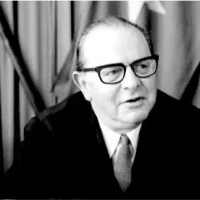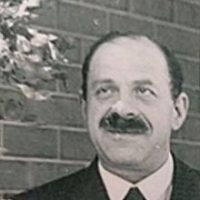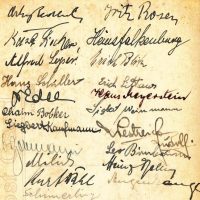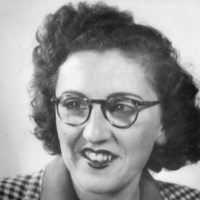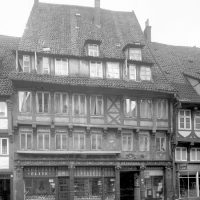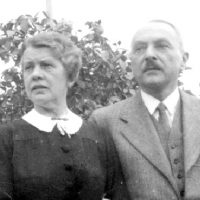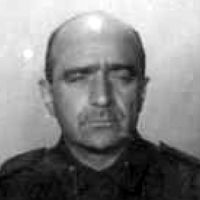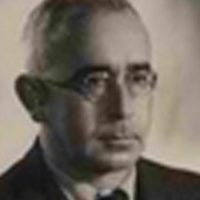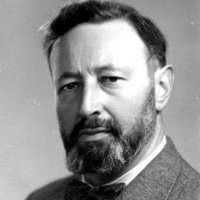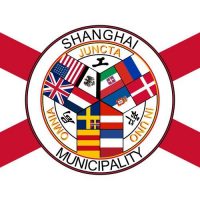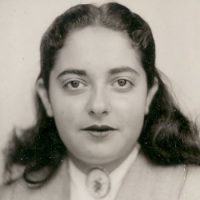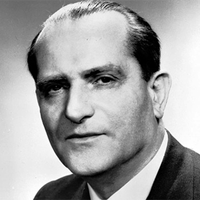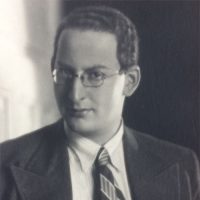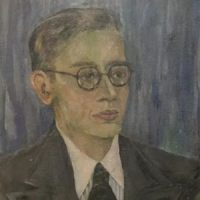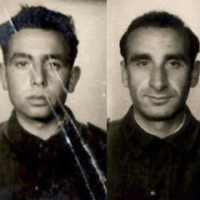Shanghai was occupied by Japan since 1932. However, an “International Settlement[1] Wikipedia about the Shanghai-Settlement and the history of the city (German), retrieved Aug 10, 2023.” had been preserved, in which 14 countries were officially involved. Because no visa was required, Shanghai was a popular, albeit distant, escape destination for up to 18,000 Jews after the annexation of Austria and the November pogroms of 1938. The Jewish actress Eva Schwarcz and other refugees had also found a place to stay there and carried out anti-fascist cultural work. On December 8, 1941, the day after the attack on Pearl Harbour, the Japanese marched into the Settlement, removed the international administration and interned all foreigners they could find.
Peter Dehn, May 2024.
Eva Schwarcz and some friends were able to escape this. The name “Shanghai 12” of this group of Jewish and anti-fascist intellectuals can be traced back to the US filmmaker Pete Vanlaw[2] Pete Vanlaw „Eva Baruch – Actress, Activist or Spy“ 2014, retrieved April 15, 2021., a relative of Eva. Because the Dehn family was probably not only connected to her, the group is presented here in short biographies. Last but not least: The activities of this group in Melbourne are also part of Jewish exile life in Australia, even if they are not directly connected to the Dunera.
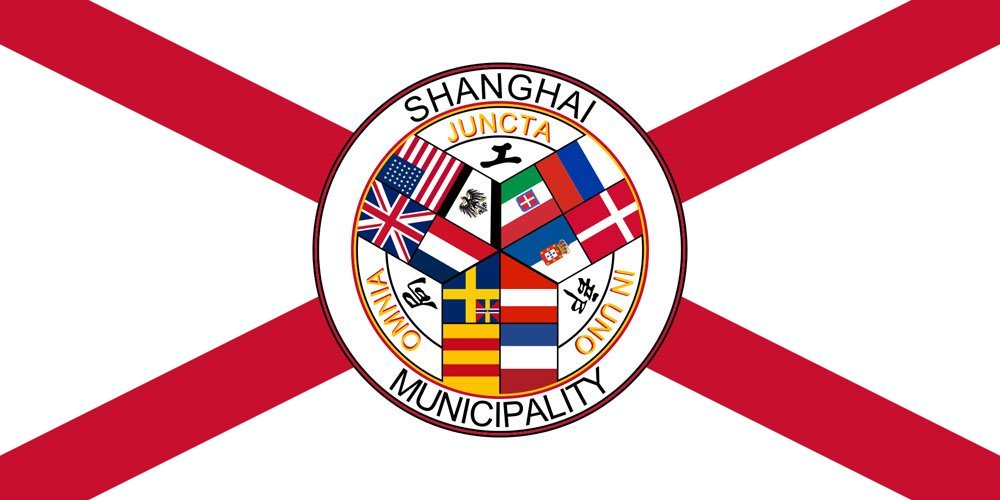
From China to Australia
The “Shanghai 12” were lucky: they were given places on the SS Cape Fairweather. It was probably the last ship that was able to leave Shanghai. The voyage began on December 3, 1941 – just a few days before the Japanese invaded the Settlement. It was characterized by the fact that the US-flagged freighter constantly had to avoid Japanese warships and the route led via Singapore and Hong Kong. The voyage was thus extended. Only after almost four weeks at sea, on December 30, 1941, did the exhausted passengers finally reach their destination: Melbourne. The “Shanghai 12” settled down there. They not only had an anti-fascist attitude in common. According to research by Pete Vanlaw, all of them are said to have collaborated in some way with the British Ministry of Information and its institutions in Shanghai.
Eva and Josef Schwarcz – Voices on the radio
Eva Baruch[3] Evas biography in „Exilograph“ (German) no. 1/1997 was taken into account here despite some inaccuracies, retrieved May 10, 2022. was born in Berlin on February 20, 1919. Like her mother Käte, she became an actress. As a Jew, the young woman could only perform in the theater of the Jewish Cultural Association in Berlin in the 1930s. She emigrated with her mother to Shanghai in 1938, where she performed in plays in German and Yiddish at theaters in exile. There she met the theater people Karl Bodan and Mark Siegelberg, among others. She was employed by the British Ministry of Information’s radio station XGDN “The Voice of Democracy” to produce a weekly program. The British had set up the station to counteract XGRS[4] Cf. Wikipedia about XGRS, retrieved Dec 15, 2022. which was run by the Nazis in Shanghai and broadcasted Nazi propaganda in six languages. Among other things, she wrote a radio play for XGDN based on the experience report “Die Moorsoldaten[5] Wolfgang Langhoffs book "Peat Bog Soldiers" (Die Moorsoldaten) was published first 1935 in Switzerland. Langhoff was co-author of the song (German) of the same name. It was written in 1933 in the Börgermoor concentration camp and is still the best-known song of the German resistance to this day.” (“Peat Bog Soldiers”) about the Nazi concentration camp near Börgermoor[6] Wikipedia (German) about the Börgermoor concentration camp, retrieved March 10, 2023.. It cannot be proven that Eva Schwarcz also worked secretly for the British, as Vanshaw claims.
In August 1938, she married the Viennese painter Josef Schwarcz, born in 1910, who worked for the British consulate, and became an Austrian. As a Jew and due to her membership of the Communist Party, she was doubly endangered in Shanghai in view of the Japanese threat.
When Eva and Josef arrived in Melbourne with the “Shanghai 12” in the last days of December 1941, Eva was pregnant. Their son Peter Michael was born in Melbourne in July 1942. Eva’s passport photo taken for the Australian authorities when she entered the country shows a woman clearly marked by hardship – even though she was only 22 years old.
After some time, Eva and Josef separated. Eva kept her son with her and earned her living as a seamstress in a clothing store. In Melbourne, Eva joined the Heinrich Heine League, in which Nazi opponents of different political views engaged in joint cultural activities. She soon became the spokesperson for the small exile organization. Interesting fact: Heinz Dehn’s home in the Melbourne suburb of Windsor is given as the postal address on a surviving headed note.
However, it was difficult for Eva to find a job as actress in Australia. So Eva Schwarcz and her mother Käte Baruch, who had only arrived from Shanghai at the beginning of 1947, decided to return to Germany. This also made sense because Eva’s friend from the Jewish Cultural Association, Fritz Wisten[7] Wikipedia (German) about Fritz Wisten, retrievend Oct 5, 2023., promised professional help in East Berlin.
Eva paid a high price for this, as she was not allowed to take her son with her. Josef had withdrawn his original consent: Staying in Germany was bad for a Jewish child. He enforced this against in court[8] „Father gets Custody in Unusual Case“, The Argus (Melbourne) July 22, 1947, National Library of Australia, retrieved June 22, 2022.. From Germany, she tried to in touch[9] Documents of Dehn family archive. with her son Peter Michael via Heinz Dehn. Josef Schwarcz lived just a few hundred meters away from Heinz Dehn.


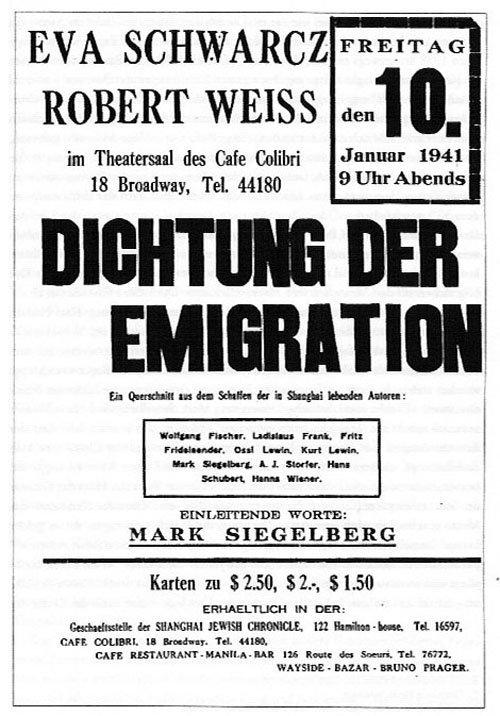
Programme sheet of a performance by Eva Schwarcz in Melbourne, in which other “Shanghai 12” were involved.
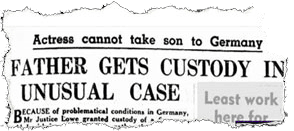
Their journey had taken mother and daughter to East Berlin in mid-July 1947. Soviet-occupied East Germany was seen by the returnees from exile (in contrast to the West) as a place of hope for the construction of an anti-fascist and democratic country. The suppression of the uprising on June 17, 1953 put Eva at odds with the communist party SED, from which she was expelled. After that, she was almost only able to work in provincial theaters. In March 1961, just a few months before the Wall was built, she left the GDR with her second husband, the radio presenter Georg Peter Puder. They both lived in Cologne and worked for radio stations, including the state foreign radio station of the Federal Republic of Germany, Deutsche Welle.
At the age of just 46, Eva died on April 25, 1966 in Freiburg after complications from a tuberculosis operation[10] Wikipedia about Eva Schwarcz (German), retrieved June 6, 2022.. Georg Peter Puder married a well-known presenter and pop singer in September 1967, a marriage that attracted a great deal of media attention[11] Cf. „25 Jahre Wochenblatt“ 1992, retrieved Sep 20, 2023.. He died in 1998[12] Cf. Radio Melody (German), retrieved June 6, 2022..
Ernst and Frieda Platz – from Buchenwald via Shanghai to Melbourne
Ernst Platz and Heinz Dehn may have met in Buchenwald concentration camp. Franz Lebrecht may also have been one of the concentration camp comrades whom Ernst met again in Australia. In any case, the name Ernst Platz is remembered from conversations with the Dehn family.
Ernst Platz, born in Brühl near Cologne in 1906, was imprisoned in the Buchenwald concentration camp[13] Card index Ernst Platz of Buchenwald concentration camp, Arolsen archvies. as a Jew with the number 5905 from June 15, 1938 to June 30, 1939. One of the things he reported from this time was the solidarity of the political prisoners: the socialist underground in the camp had offered him membership, protected him and advised him to train his memory so that he would later be able to report accurately on what he had experienced[14] Cf. Michael R. Marrus (ed..) „The Nazi Holocaust“, Part 2, page 638.. On the advice of his comrades, he injured his hand to avoid being forced to do hard labor.
His wife Frieda Rau was born in 1903. They had married in Berlin in 1933 and were now awaiting his release. They saw their prospects far away from Nazi Germany in visa-free Shanghai. In the international zone, they made contact with other exiles; Ernst worked there as a journalist[15] Cf. „Emigranten Adressbuch“ of 1939, page 97, retrieved Aug 17, 2023.. Ernst and Frieda had to leave this place of exile in 1941 and arrived in Melbourne with their ten fellow sufferers on December 30, 1941.

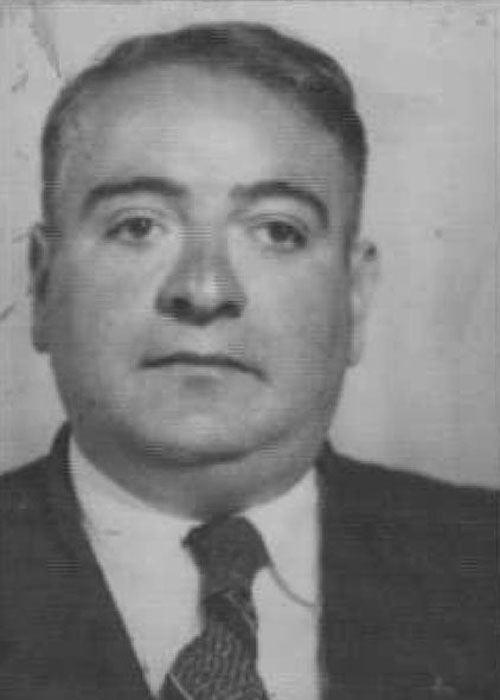
Before they could build a new life in Australia, Ernst Platz signed up to serve in a work unit of the Australian army. This may have made it easier for them to remain Down Under in the long term – as was the case with the Dunera Boys, who were also denied military service under arms. In March 1942 – less than three months after arriving in Australia and like “Shanghai 12” comrade Egon Varro – Ernst was drafted into the 4th Employment Company, from which he was discharged as a Lance Corporal on June 19, 1945. Ernst and Frieda became Australian citizens in February 1948.
Ernst Platz remained politically active. After his time in the army, he worked for the Jewish Council to Combat Fascism and Anti-Semitism[16] Salomea Genin „Ich folgte den falschen Göttern“ (I followed false gods) Berlin 2012, page 54.. Among other things, this organization drew attention to fascist tendencies and attacks against Jewish institutions in Australia. The organization was led by the writer and communist Judah Waten (1911 – 1985). Platz was its secretary general[17] Cf. „The Jewish Herald“, Melbourne from Dec 22, 1967 in NAA_ItemNumber4025323, retrieved Jan 15, 2024, „Neues Deutschland“, Dec 17, 1960. from 1960 to 1967. In the 1961 elections to the Australian Parliament, he stood as a candidate for the Labor Party in the Melbourne district of Balaclava, but was not elected.
Ernst Platz died on August 17, 1969[18] Cf. family trees at my heritage, accessed on 10 October 2023.. To this day, the Australian National Archives has kept some of his files under lock and key[19] Cf. Files at National Archives of Australia (NAA) about Ernst Platz, retrieved Aug 19, 2022.. One of the reasons given for this is that the security of the country and informants are at risk. Publicly accessible digitized ASIO files on the Jewish Council also show that Ernst Platz was listed at ASIO under the number VPF 1397[20] Cf. Files about Jewish Council at National Archiv Australien (NAA), among others: NAA_ItemNumber837221, NAA_ItemNumber1801106, NAA_ItemNumber3086601, NAA_ItemNumber4025323, NAA_ItemNumber12762745.. Accessible documents date back to early 1967.
Karl and Olga Bodan – about tobacco ant theatre
Karl Bodan and his wife Olga[21] Cf. Entry for Hayegg-Bodan, Olga in „Biografisches Lexikon der Theaterkunst“, 1998, page 388. were also theater people. An acquaintance with Heinz Dehn can be confidently assumed – and not only because of Dehn’s contacts with Eva Schwarcz and Ernst Platz.
Karl Bodan was born in Vienna on September 9, 1894. His wife Olga, née Hajek (also: Hayegg) was born in Prague on June 28, 1899. It is not known when the actor and director and the opera singer met and under what circumstances they came to Shanghai. Nevertheless, together with Eva Schwarcz, Mark Siegelberg and others, they contributed to a diverse anti-fascist oriented theater landscape for the large German-speaking community. Bodan staged plays by Curt Goetz and others in German as well as Upton Sinclair’s “Last Hope” in Yiddish. Olga was given roles in many performances.
The move to Melbourne also brought a serious career break for the Bodans. First of all, they had to make a living. The only six digitized sheets of Australian files show that Karl named a hairdressing business “Bodan & Kann” as his employer in 1948, while Olga stated that she worked as a tobacconist for this company.
The address of “Bodan & Kann” was 7 Chapel Street[22] The house number no longer exists today; the building was probably sacrificed in 1968 when Dandenong Road was widened to form the Princes Highway, thereby enlarging the intersection with Chapel Street enormously. in the Melbourne suburb of St. Kilda. Heinz Dehn and his future wife Ida Flieder lived at 109 Wellington Street, less than 300 meters away. What was to stop Heinz, a heavy smoker, from buying his cigarettes in the nearest store, having his hair cut there and helping a fellow exile in the process?
But who was the Bodans’ partner called Kann? Unfortunately, there are no records of this in Australian archives. However, one answer might be obvious: the Kann family, who were deported from Singapore to Australia in 1940 on the Queen Mary, also came from Vienna. The father Siegfried was born in Vienna in 1877 and was an accountant. In 1908, he married Johanna Zuckermann, a singing teacher born in Komotau (now Chomutov, Czech Republic) in 1886. Their son Herbert was born in Vienna in 1909 and studied engineering. After his release from the Tatura 3 internment camp, Herbert served in the 8th Employment Company for four months and became an Australian citizen in 1945. He died in Melbourne in 1988. After Siegfried died in 1948, Johanna joined her second son Theodor in the USA, where she became a naturalized citizen in 1954.
Were Herbert or Siegfried the Bodans’ partners?
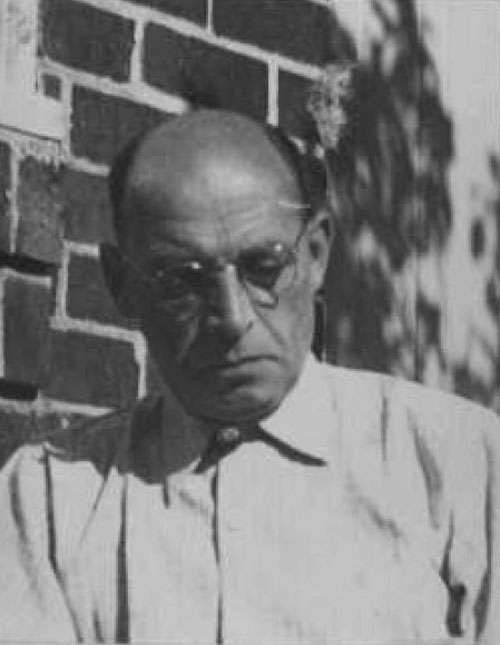
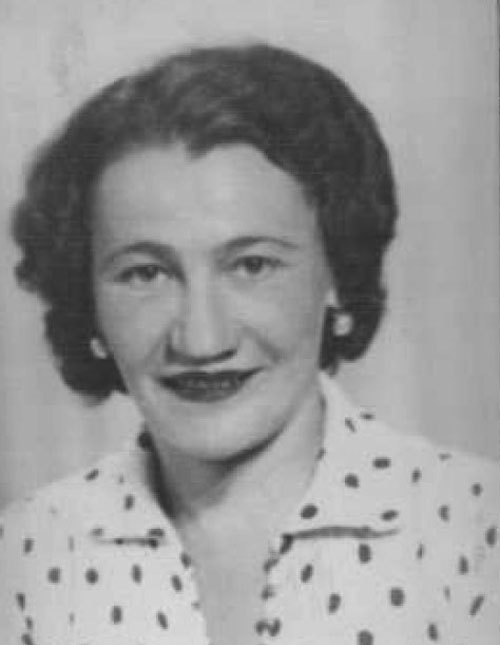
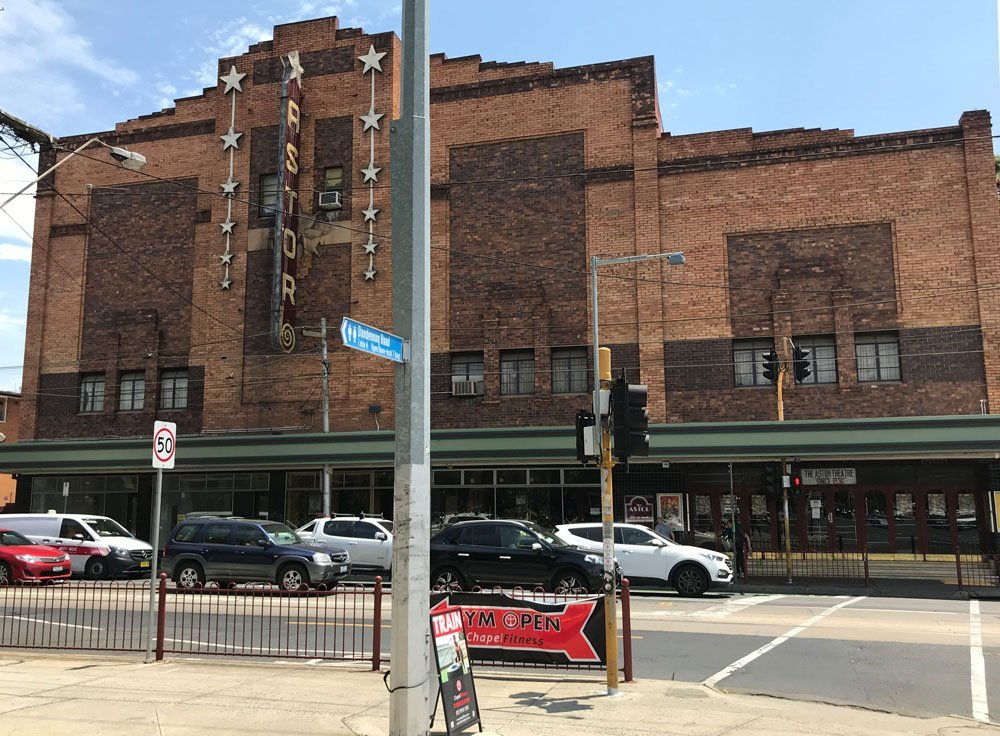
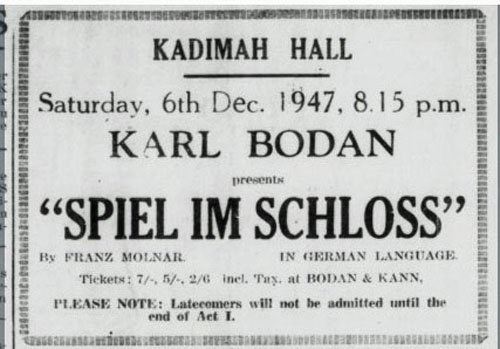
In parallel to securing their livelihood, the Bodans sought to connect with Melbourne’s theater life and produced, among other things, Franz Molnar’s “Play in the Castle” in German at the end of 1947. “Bodan & Kann” was named in the advertisement as the only point of sale for tickets. The production was performed in various venues until at least 1950.
It seems that “Bodan & Kann” was the financing basis for the Bodans to have their own stage. The late entry of the Bodans and other exiled artists into Melbourne’s cultural world in the mid-1950s “may have had to do with the slow establishment of emigrants in Australian society”, theater historians speculate[23] Birgit Lang „The Earnestness of beeing Importer. ‚Österreichisches‘ Theater und Kabarett im australischen Exil“, 2002, Salzburg University, retrieved Sep 5, 2023.. The potential of actors that the producers of German-language plays had to “share” was certainly limited. In 1956, on the occasion of the 25th anniversary of Arthur Schnitzler’s death, the Bodans’ “Kleines Theater” played his “Anatol” and the exile play “Fremde Erde” by Mark Siegelberg and Hans Schubert. But it was difficult to retain an audience permanently. So it seems that the “Kleines Theater” project had little chance of survival.
The Bodans, Australian citizens since 1948, decided to return to Vienna. Karl died there on May 23, 1960 and Olga on November 9, 1979.
Mark and Amalie Siegelberg – between journalism and theatre
Mark Siegelberg[24] Wikipedia about Mark Siegelberg, retrieved Sep 20, 2022. was born on June 11, 1895 in Luck (then Poland, now Lutsk, Ukraine) about 150 km north of Lviv. He completed his studies in law and economics with doctorates. In Vienna, where the family had emigrated during his childhood, he worked as a journalist for the newspapers “Der Morgen”, “Die Stunde” and “Der Tag” from 1922 onwards. From 1934 to 1938 he was editor of the “Stunde”. He had been married to Amalie Juran, born on May 8, 1893 in Brno, since 1924.
The Nazi regime annexed Austria on March 12, 1938. Mark Siegelberg was now doubly at risk as a Jew and journalistic critic of National Socialism. Like many other Nazi opponents, he was arrested shortly after the invasion and taken to the Dachau concentration camp on April 2, 1938. The Nazis prevented their opponents from taking part in the (already manipulated) referendum of April 10, 1938 by imprisonment, which was intended to give the invasion a democratic mantle.
In Dachau, Mark Siegelberg was listed with the number 13877. On September 23, 1938 he was transferred to the Buchenwald concentration camp[25] Card index of Buchenwald concentration Camp for Mark Siegelberg, Arolsen archives., where he was given the number 9670. It cannot be proven whether Mark Siegelberg, Heinz Dehn, Franz Lebrecht and other later “Australians” already met in Dachau or Buchenwald. He may have been brought to Buchenwald in the same transport as Dehn or Lebrecht. The Nazis stripped him of his academic titles. It was not until mid-1955 that he was officially allowed to use his doctorate again.
Released from prison on April 22, 1939, Mark and Amalie were able to escape to Shanghai[26] Cf. Application to the emogration department of Jüdischen Kultusgemeinde Wien from July 1, 1938, last permit allowed 370 Reichsmark subsidy towards own share of travel cost from Dec 26, 1938. which they had been preparing for almost a year. On the crossing he wrote a book about his time in the concentration camp. In 1940 he combined his Dachau camp number and the note on his index card “Sch J” to create the title of his concentration camp report “Schutzhaftjude Nr. 13877[27] With „Ein Mann namens Brandt“ by Siegelberg, published by Theodor Kramer Gesellschaft 2022, ISBN 978-3-901602-96-2.” (Protective Custody Jew No. 13877). The plays “Die Masken fallen” (The Masks Fall) and “Fremde Erde” (Foreign Earth) were created in Shanghai, with which he and his co-author Hans Schubert provoked a protest from the Reich Ambassador. As a journalist, Karl supported the exile magazines “The Shanghai Herald” and “Shanghai Jewish Chronicle”.
The British Ministry of Information repaid the cooperation in his case by evacuating him to Australia. In 1948 he named the Ungar Trading Co.[28] NAA files Mark Siegelberg, NAA_ItemNumber4110190., a carpet trade in the Melbourne business district, as his employer. But journalism and theater didn’t let him go. In 1954 he founded the magazine “Neue Welt[29] Wikipedia about „Neue Welt“ (Grrman), retrieved April 20, 2023.” in Melbourne as a bilingual “Australian-German weekly”. Siegelberg dealt, among other things, with immigration issues and reported from German-speaking countries as well as about Israel and Judaism. There were also extensive sports and entertainment sections.
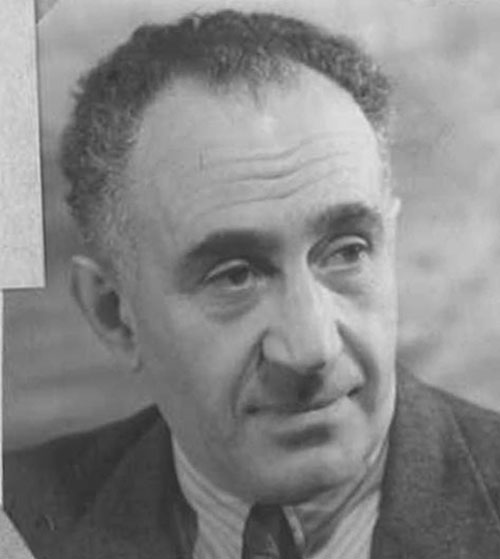


Mark Siegelberg’s index card of the Dachau concentration camp. Source: Arolsen Archives.

Title page of a programme booklet of the “Little Theatre” in Melbourne for Siegelberg’s exile play “Stranger Earth”.
The concept was well received by readers and advertisers alike, including many entrepreneurs of German origin. After just one year, Siegelberg switched from a fortnightly to a weekly publication. After changing its name in the 1980s, the paper was published until 2004. In the 1950s, he had also supported the Bodans’ Little Theatre.
In 1968, Mark Siegelberg, now aged 73, retired from his professional activities. He and Amalie went back to Austria. He died in Katzelsdorf near Vienna on 4 December 1986.
Hans Cecil Rosenberg – a radio announcer
Hans Rosenberg was an actor and worked in Shanghai as a radio announcer. He was born on February 10, 1910 in Berlin as one of three sons[30] Cf. Biography of Julius Rosenberg, Stolpersteine Hamburg (German), retrieved Oct 19, 2022. of Eugen Rosenberg and Frida Magnus. Hans’ older brother Julius, who had last practiced as a doctor in the Netherlands, and his family were deported in 1943 and murdered in Auschwitz. His mother and brother Herbert (*1908) was able to emigrate to the USA.
The job description “radio announcer” could indicate that Hans Cecil Rosenberg also worked for the British radio station XGDN in Shanghai. In Australia he served shortly after arrival – from March 30, 1942 to January 3, 1946 – in the 6th Employment Company. Nothing is known about his further stay there. What is clear, however, is that he soon returned to Germany.

The photo for Hans Rosenberg’s Australian foreigner’s identity card was taken in 1942. source: NAA_ItemNumber6255458.
He died in Berlin on March 28, 1950 after suffering from lung cancer[31] Registry office Berlin, no. 768 from March 29, 1950. and was buried in the Weissensee Jewish cemetery. His mother Frida, who died a few months after him in Detroit, was buried at his side.
Adolf J. Storfer – “Freud’s most faithful evangelist“
Adolf (Albert) Josef Storfer[32] Wikipedia about A.J. Storfer (German), retrieved Sep 15, 2022. was also an employee of Radio XGDN in Shanghai and as such an employee of the British Ministry of Information, as he noted on the questionnaire when entering Australia[33] NAA files A.J. Storfer, NAA_ItemNumber7113401.. Before that, however, the son of a timber merchant and a banker’s daughter, who was born on January 11, 1888 in Botosani (Romania), had an experience that shaped his life. He studied literature and law in order to then train as a journalist.
In 1910 he sent his text “Zur Sonderstellung des Vatermordes” (On the Special Position of Patricide) to Sigmund Freud in Vienna, which the father of psychoanalysis took note of favorably. After the First World War, Storfer went to Vienna and worked for a specialist publisher co-founded by Freud. Storfer, Freud’s daughter Anna and Otto Rank published Sigmund Freud’s twelve-volume “Collected Writings” there from 1924 onwards. This and other publishing projects proved to be risky because of the complex and expensive design and the rather low buyer potential. The publisher went into debt, Storfer left and, among other things, dealt with the psychological causes of anti-Semitism[34] Christof Goddemeier „Geist von der Eindringlichkeit eines Drillbohrers“ (Spirit with the forcefulness of a drill, German), in „Ärzteblatt“, Nov 2019, page 510, retrieved Aug 20, 2023..
Storfer was refused a visa for the USA or Switzerland. So the only option was to travel to visa-free Shanghai. There he founded the magazine “Gelbe Post”, which first appeared on May 1, 1939. Much praised, the paper’s financial situation only stabilized after donations from the USA. Did that tempt Storfer to take further risks and switch to appearing every day? The “Gelbe Post” had not been on the market for long when Nazi agents in Shanghai saw their criminal world view tarnished and set their sights on Storfer: “Der Stürmer” in July 1939 ran an anonymous article about the “Jew A. J. Storfer”, psychoanalysis and their “degenerate Jewish sense of gender for the peoples of all races (…). This teaching is a complete Jewish mess. (…) The Chinese people, who are already very badly corrupted by communism, should completely perish because of his poison.”
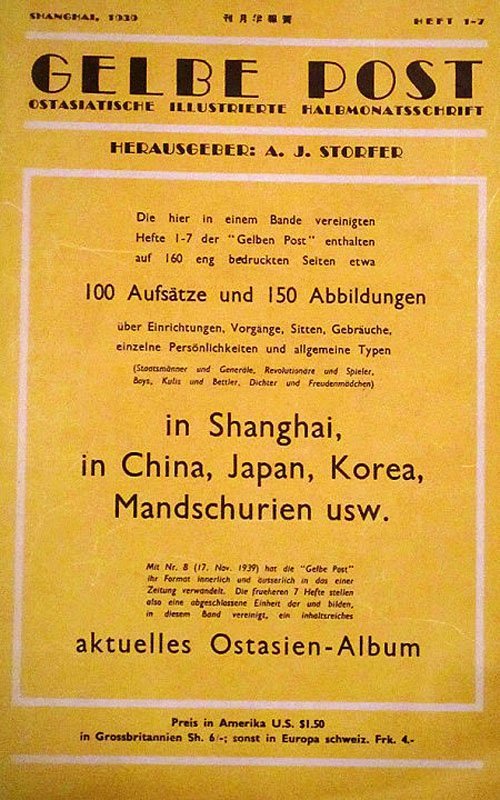
The front page of the “Gelhe Post”.
At the end of August, Storfer had to give up the magazine under external pressure. Due to the high workload and the unfamiliar climate, he suffered a heart attack. Then came the evacuation to Australia as one of the “Shanghai 12”. He couldn’t regain his footing there. He worked in a sawmill and as a button turner. On December 2, 1944, he died in a Melbourne hospital from complications of pneumonia.
An obituary by Alfred Polgar[35] Quoted from Roland Kaufhold „Die gelbe Post – eine deutschsprachige Emigrantenzeitschrift aus Shanghai“, hagalil.com, 14.6.2018, retrieved Aug 20, 2023. is often quoted: “Sigmund Freud’s most faithful evangelist, in a wood turnery. Maybe he did it out of necessity. It would not be out of the question for Storfer to have been won over by the idea that turning buttons was a more sensible activity than writing books.”
Egon Varro – a “somewhat combative” journalist
Egon Varro was also a journalist. He was born on June 6, 1919 in Berlin.
Probably as an “Aktionsjude” he was imprisoned in Sachsenhausen[36] Response from the Sachsenhausen Memorial dated 13.4.2025 to a request from dunera.de. concentration camp with the prisoner number 8914 until November 29, 1938. On December 27, 1938, he left Bremen on the Gneisenau for Shanghai. He was listed as a musician in the emigrant address book[37] „Emigranten Adressbuch“ loc.cit. p. 119, retrieved Aug 17, 2023. there from 1939. In July 1939 he founded the small newspaper “Der Querschnitt” (Crosssection) to shed light on the common interests of emigrants. “The editor, Egon Varro, showed a critical and somewhat combative attitude[38] Hartmut Walravens „German Influence on the Press in China“, conference paper from August 1996, retrieved Sep 20, 2022.“, says one chronicler. He also worked for the British Ministry of Information and was evacuated to Australia on the Cape Fairweather.
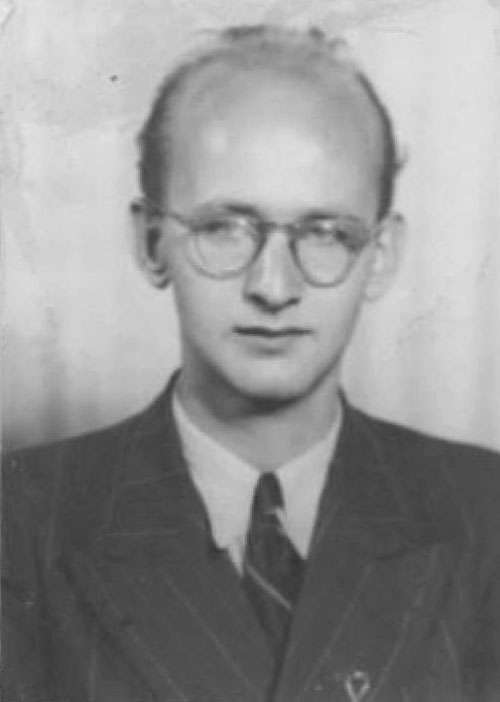
Egon Varro’s passport photo for registration in Australia. Source: NAA_ItemNumber 6555612.
Like Ernst Platz, he immediately enroled to the army and joined the same unit, the 4th Employment Company, on March 18, 1942. He received fines for failing to appear at roll call and violating the code of conduct. He was released from service[39] Army files Egon Varro, NAA_ItemNumber6255503. on February 22, 1944 for health reasons: he was certified as having a “schizoid personality”.
In October 1947 he was naturalized[40] NAA files Egon Varro, NAA_ItemNumber31676760. in Australia. In the same year he married the 23-year-old Maria Letitia Kloppenburg (1924 – 1995), who emigrated from the Netherlands to Australia with her parents[41] Cf. Quarantine Service list of SS Gorgon at Fremantle, via ancestry.de. and two sisters in 1934.
In Australia he worked as a journalist – for local publications and as a correspondent for West German publishers. However, his reports do not always seem to have struck a chord with the editors. Varro had received a request not to switch from sending his texts by airmail[42] Cf. „Post War Australia“ Time Magazine 1960, retrieved Sep 25, 2023. to fast cable “unless half the continent is blown away.” This coincided with the Australian government’s attempt to ban the Communist Party[43] Cf. Humphrey McQueen „Social Sketches of Australia“ 1979, ISBN 978-0140044355. Page 231. More: Wikipedia about the Petrov-affair, retrieved May 15, 2023.. The claim that the party was acting as an intelligence for the Soviet Union could never be proven despite a Russian defector (Petrov affair) and the plan failed. Perhaps the media reticence in the Federal Republic was also due to the fact that the ban the Communist Party was being prepared there and the topic was to be kept small.
Egon Varro died on April 22, 1976[44] Cf. files about Egon Varro on ancestry.de, retrieved March 10, 2023. in Melbourne.
Roman Zieher – a doctor in exile
In contrast to the other “Shanghai 12”, Roman Zieher had his profession not in the artistic field. He was born on February 14, 1902 in Lemberg (then Poland, now: Lviv, Ucraine) and became a doctor. The fact that he was Jewish was certainly the main reason for his escape, which initially took him to visa-free Shanghai. Little is known about his time in Australia: in 1943 he married Maria Yvonne Sterne[45] Sales contract Sterne from 1940, NAA_ItemNumber5488154. The sports teacher was born in Brno in 1905. On the notice of his naturalization dated June 12, 1947, there is a “Warning notice[46] Sales contract Sterne from 1940, NAA_ItemNumber5488154. given on 29/1/47″ from a “Security Service”. However, this uninterpretable note apparently could not prevent him from setting up as a general practitioner in Melbourne.
Roman Zieher died on November 10, 1984[47] Estate records of Victoria, quoted from ancestry.com..

The passport photo was taken around 1942. Source: NAA_ItemNumber 6543576.
Footnotes
show
- [1]↑Wikipedia about the Shanghai-Settlement and the history of the city (German), retrieved Aug 10, 2023.
- [2]↑Pete Vanlaw „Eva Baruch – Actress, Activist or Spy“ 2014, retrieved April 15, 2021.
- [3]↑Evas biography in „Exilograph“ (German) no. 1/1997 was taken into account here despite some inaccuracies, retrieved May 10, 2022.
- [4]↑Cf. Wikipedia about XGRS, retrieved Dec 15, 2022.
- [5]↑Wolfgang Langhoffs book "Peat Bog Soldiers" (Die Moorsoldaten) was published first 1935 in Switzerland. Langhoff was co-author of the song (German) of the same name. It was written in 1933 in the Börgermoor concentration camp and is still the best-known song of the German resistance to this day.
- [6]↑Wikipedia (German) about the Börgermoor concentration camp, retrieved March 10, 2023.
- [7]↑Wikipedia (German) about Fritz Wisten, retrievend Oct 5, 2023.
- [8]↑„Father gets Custody in Unusual Case“, The Argus (Melbourne) July 22, 1947, National Library of Australia, retrieved June 22, 2022.
- [9]↑Documents of Dehn family archive.
- [10]↑Wikipedia about Eva Schwarcz (German), retrieved June 6, 2022.
- [11]↑Cf. „25 Jahre Wochenblatt“ 1992, retrieved Sep 20, 2023.
- [12]↑Cf. Radio Melody (German), retrieved June 6, 2022.
- [13]↑Card index Ernst Platz of Buchenwald concentration camp, Arolsen archvies.
- [14]↑Cf. Michael R. Marrus (ed..) „The Nazi Holocaust“, Part 2, page 638.
- [15]↑Cf. „Emigranten Adressbuch“ of 1939, page 97, retrieved Aug 17, 2023.
- [16]↑Salomea Genin „Ich folgte den falschen Göttern“ (I followed false gods) Berlin 2012, page 54.
- [17]↑Cf. „The Jewish Herald“, Melbourne from Dec 22, 1967 in NAA_ItemNumber4025323, retrieved Jan 15, 2024, „Neues Deutschland“, Dec 17, 1960.
- [18]↑Cf. family trees at my heritage, accessed on 10 October 2023.
- [19]↑Cf. Files at National Archives of Australia (NAA) about Ernst Platz, retrieved Aug 19, 2022.
- [20]↑Cf. Files about Jewish Council at National Archiv Australien (NAA), among others: NAA_ItemNumber837221, NAA_ItemNumber1801106, NAA_ItemNumber3086601, NAA_ItemNumber4025323, NAA_ItemNumber12762745.
- [21]↑Cf. Entry for Hayegg-Bodan, Olga in „Biografisches Lexikon der Theaterkunst“, 1998, page 388.
- [22]↑The house number no longer exists today; the building was probably sacrificed in 1968 when Dandenong Road was widened to form the Princes Highway, thereby enlarging the intersection with Chapel Street enormously.
- [23]↑Birgit Lang „The Earnestness of beeing Importer. ‚Österreichisches‘ Theater und Kabarett im australischen Exil“, 2002, Salzburg University, retrieved Sep 5, 2023.
- [24]↑Wikipedia about Mark Siegelberg, retrieved Sep 20, 2022.
- [25]↑Card index of Buchenwald concentration Camp for Mark Siegelberg, Arolsen archives.
- [26]↑Cf. Application to the emogration department of Jüdischen Kultusgemeinde Wien from July 1, 1938, last permit allowed 370 Reichsmark subsidy towards own share of travel cost from Dec 26, 1938.
- [27]↑With „Ein Mann namens Brandt“ by Siegelberg, published by Theodor Kramer Gesellschaft 2022, ISBN 978-3-901602-96-2.
- [28]↑NAA files Mark Siegelberg, NAA_ItemNumber4110190.
- [29]↑Wikipedia about „Neue Welt“ (Grrman), retrieved April 20, 2023.
- [30]↑Cf. Biography of Julius Rosenberg, Stolpersteine Hamburg (German), retrieved Oct 19, 2022.
- [31]↑Registry office Berlin, no. 768 from March 29, 1950.
- [32]↑Wikipedia about A.J. Storfer (German), retrieved Sep 15, 2022.
- [33]↑NAA files A.J. Storfer, NAA_ItemNumber7113401.
- [34]↑Christof Goddemeier „Geist von der Eindringlichkeit eines Drillbohrers“ (Spirit with the forcefulness of a drill, German), in „Ärzteblatt“, Nov 2019, page 510, retrieved Aug 20, 2023.
- [35]↑Quoted from Roland Kaufhold „Die gelbe Post – eine deutschsprachige Emigrantenzeitschrift aus Shanghai“, hagalil.com, 14.6.2018, retrieved Aug 20, 2023.
- [36]↑Response from the Sachsenhausen Memorial dated 13.4.2025 to a request from dunera.de.
- [37]↑„Emigranten Adressbuch“ loc.cit. p. 119, retrieved Aug 17, 2023.
- [38]↑Hartmut Walravens „German Influence on the Press in China“, conference paper from August 1996, retrieved Sep 20, 2022.
- [39]↑Army files Egon Varro, NAA_ItemNumber6255503.
- [40]↑NAA files Egon Varro, NAA_ItemNumber31676760.
- [41]↑Cf. Quarantine Service list of SS Gorgon at Fremantle, via ancestry.de.
- [42]↑Cf. „Post War Australia“ Time Magazine 1960, retrieved Sep 25, 2023.
- [43]↑Cf. Humphrey McQueen „Social Sketches of Australia“ 1979, ISBN 978-0140044355. Page 231. More: Wikipedia about the Petrov-affair, retrieved May 15, 2023.
- [44]↑Cf. files about Egon Varro on ancestry.de, retrieved March 10, 2023.
- [45]↑Sales contract Sterne from 1940, NAA_ItemNumber5488154
- [46]↑Sales contract Sterne from 1940, NAA_ItemNumber5488154.
- [47]↑Estate records of Victoria, quoted from ancestry.com.
